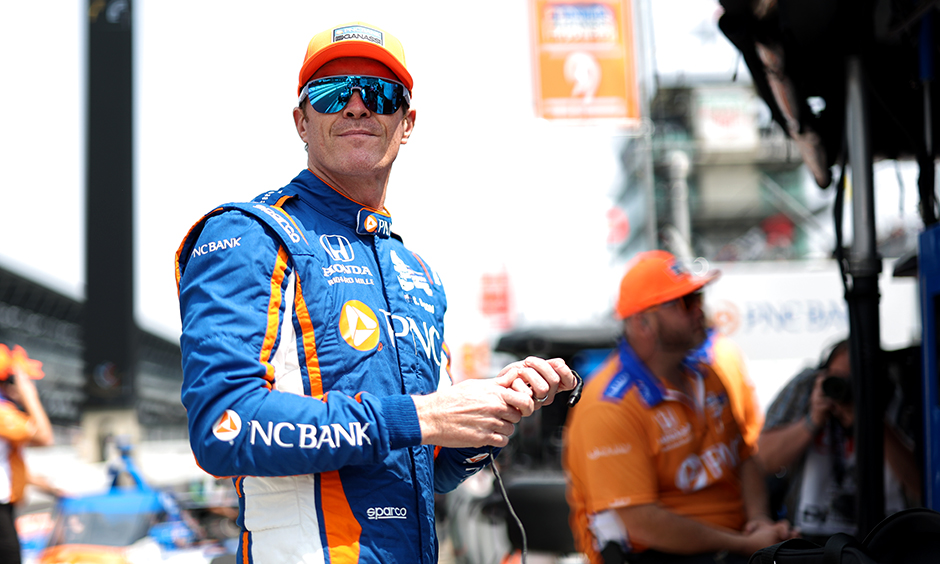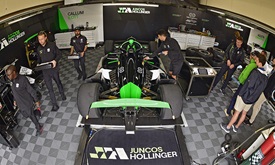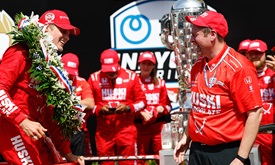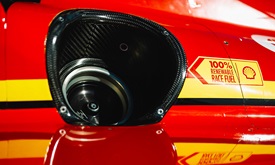Dixon Hopes To Drive into History in Indy 500 Qualifying
MAY 19, 2023
The greatest qualifier in Indianapolis 500 history acknowledged Friday that Scott Dixon is all but in his class.
This weekend, Dixon can tie the legendary Rick Mears for the most poles in “500” history with six. If Dixon is successful, he also would become the first driver to win three Indy poles in a row.
Think about that. Seven-hundred ninety-one drivers have earned a place in at least one race at Indianapolis Motor Speedway, with another hundred or so men and women – maybe more – who tried but failed. That’s over 106 previous events.
“If he gets it,” Mears said of Dixon, “he’s earned it.”
Dixon won his first pole at Indy in 2008, netted three more in the next decade and already has two since 2020. Time shows how impressive that is.
Since Tom Sneva was breaking the 200-mph barrier as part of his back-to-back pole runs in 1977-78, only three other drivers have won Indy poles in succession. Scott Brayton (1995-96) never got the chance to three-peat, and Helio Castroneves (2009-10) and Ed Carpenter (2013-14) couldn’t pull it off, qualifying 16th and 12th, respectively, in their bids for making history.
Dixon heads to the weekend as one of the favorites to capture the No. 1 starting position for next weekend’s “500.” Dixon’s team owner, Chip Ganassi, said the pursuit is something to celebrate.
“It sounds so cliché to say, but we’re all watching and living every day with a legend – it’s that simple,” Ganassi said. “We’re all focused on (the now), but it’s surreal to be living it.”
As is his custom, Dixon dodged such praise in the moment, as he has with the subject of being one NTT INDYCAR SERIES championship win from A.J. Foyt’s all-time record of seven. But he can’t run from some things. He has won more Indy poles than Foyt, won more series races than Mario Andretti and is closing in on Tony Kanaan for the most consecutive starts in the sport’s history, an ironman mark to be sure.
Dixon is the only driver with five “500” poles – Rex Mays, Foyt and Castroneves have four. There have been 12 drivers win consecutive poles: Ralph DePalma (1920-21), Mays (1935-36), Eddie Sachs (1960-61), Parnelli Jones (1962-63), Andretti (1966-67), Foyt (1974-75), Sneva, Brayton, Castroneves, Carpenter and Dixon.
Dixon said a pole to match Mears “would be amazing,” but as is his norm he directed the attention to his team.
“The amount of effort that goes into it and the small tweaks and adjustments and everything for this race, for this weekend for the pole, is very special,” he said. “So, it’s very rewarding, and it’s always great for the team.
“I think to have all of us (on the team) in the hunt for it was very special, as well, and I’d say kind of looking at the last couple of days, the car has definitely had speed. We’ll see if that plays true come tomorrow and Sunday.”
To win this pole, a driver must qualify in the top 12 of Saturday’s session (11 a.m.-5:50 p.m.), then advance through the first batch of Sunday qualifying (2 p.m.) to reach the Firestone Fast Six (5:15 p.m.). Then, it’s game on.
Last year, Dixon beat all comers in the final round at 234.046 mph, and the Fast Six included his teammates Alex Palou (second), Marcus Ericsson (fifth) and Tony Kanaan (sixth). Takuma Sato has replaced Kanaan in the team’s fourth car, consistently pacing the field this week and turning a best lap Friday of 234.754 mph, the fastest Indy 500 practice lap since 1996. All of them should challenge for a berth on the front row, but this field is deep – “crazy competitive,” as Carpenter said Friday.
Obviously, tying a record comes if Dixon wins another pole, but being somewhere near the front likely will be important to winning the “500,” which he last did in 2008. The last six winners of the race have started in the top eight, with five of those starting in the top five. The last time a “500” winner started outside the top 10 was 2016 when Alexander Rossi won from the 11th position.
“If you have a good car, I do think you can make your way through,” Graham Rahal said. “But naturally, the further forward you are, the more you can just control your whole day and you don’t have to worry about being in ‘X’ position by Lap 50, 100, 150. If you can be up front and just stay there and kind of control the pace, it certainly helps.”
Last year, Dixon led 95 laps and was controlling things as the race leader when he got penalized for entering pit road too fast on Lap 175. He ended up 21st.
Still, Dixon has excelled in virtually every circumstance at IMS. Last year, he eclipsed the all-time race record for laps led, pushing the all-time total to 665, 21 laps more than Al Unser’s total in second place. But all drivers speak to the personal satisfaction of being the fastest of the fast, and in this era that’s Dixon.
Mears said such a distinction is personal gratification.
“To me, (qualifying) was the best part (of May),” he said. “It’s not just one lap (of qualifying) – it’s four laps, and you had to do it as the tires wear off, as the fuel burns off, as the wind changes, and you have to get all of that right. It’s exciting. It’s hard to hold your breath that long.”
If Dixon can hold his breath that long and if the No. 9 PNC Bank Chip Ganassi Racing Honda is equipped to produce the breathtaking speed, the 42-year-old New Zealander might just end up with a record at Indy that once seemed unapproachable.
“If it happens, it happens,” said Mears, whose other impressive record is 11 front-row starts, including six years in a row. “There’s the old saying, records are meant to be broken.
“Obviously, would I like to hang on to (the record)? Sure.”
He smiled, but he didn’t look all that confident. Dixon looms.



















